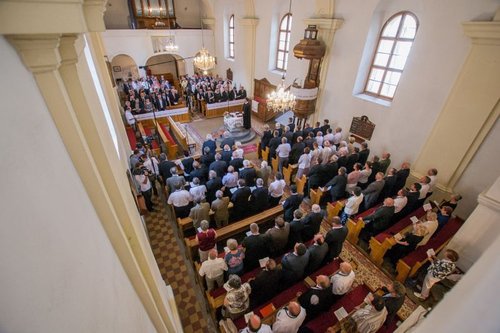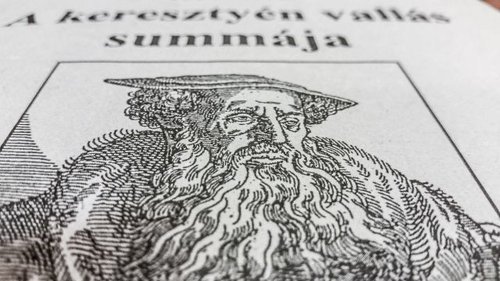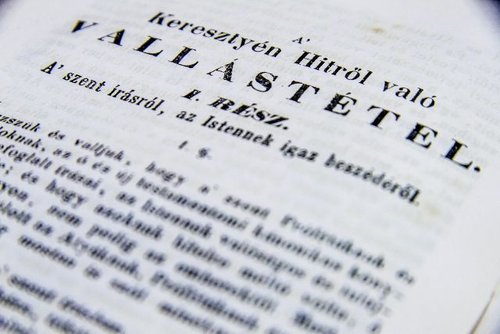The General Convent of the Hungarian Reformed Church is the representative and consulting Body of the reformed Churches in the Carpathian Basin. Its members are the acting leaderships (Bishops, Deans and Lay Presidents) of all the church districts and presbiteries of the joined Churches. It is mandated to coordinate the cooperation and to promote the unity in worship, church life and witness. The General Convent represents around 2.5 Million members of 7 reformed Churches organized in 11 Church Districts and living in 7 different countries.

Also in attendance at the HRC’s General Convent was Rev Chris Ferguson, General Secretary of the World Communion of Reformed Churches (WCRC). As an ecumenical guest of honor, Rev Ferguson addressed the plenary on matters of joint importance to the HRC and the WCRC, including the upcoming Reformation Jubilee, the plight of refugees, as well as other social justice issues. Following his time at the General Convent, Rev Ferguson visited Vizsoly, Hungary, where the first Bible printed in the Hungarian language was created, before heading on to Budapest for a short trip. During his stay in Budapest, Rev Ferguson met with Dóra Kanizsai-Nagy, Head of the Refugee Ministry of RCH, to discuss the vital work in refugee integration that is happening in the capital city. His visit to the region spotlighted WCRC’s mission to be committed to communion and justice and, in partnership with other ecumenical bodies and organizations, participate in God’s mission in the world while proclaiming the saving grace and love of our Triune God.
At the General Convent meeting, held in Kosice, Slovakia this year, reports from many different committees and networks were presented to the consulting Body. At its recent meeting, an updated translation of the Second Helvetic Confession was also announced to great excitement.

Confessions are born only when there is a living belief that makes us righteous in front of God. The confirmation catechisms and our well-prepared Sunday school teachers teach us that our Reformed Church has two confessions, the Heidelberg Catechism and the Second Helvetic Confession; we even recite the first question and answer session of the Heidelberg Catechism as part of the confirmation vow. Nowadays, however, it is only future pastors who are met with the further questions and answers and with the Second Helvetic Confession during their pastor training. In our personal devotions, in our congregational communities, and at our conferences we do not tend to make use of these confessions. However, it is not the confession that needs us to make use of it, but we ourselves need it’s guidance in our lives.
Birth of the Confession
The author of the Second Helvetic Confession was Henrik Bullinger (1504-1575), a pastor from Zurich. He wrote the Confession in 1562 – in the midst of much pain due to a serious illness – as a sort of spiritual last will or testament. In 1566 (450 years ago, in this year), the alliance of the Helvetic cantons accepted it as a common national confession – that’s why it is called ‘Helvetic’. At that time, on 1 March, 1566, “All the ministers of the Churches of Christ in Switzerland, those which are at Zurich, the ministers of Berna, the Schaffusians, the Sangalli, the High Court of Parliament of Germany, and amongst our allies on this side of, and beyond, the Alps, the Mylhusians, and the inhabitants of Bienna, have subscribed unto this confession, to whom the ministers of the Church which is at Geneva have united themselves.”
The European Reformed Churches immediately joined the movement: Scotland in 1566 and the Synod of Debrecen in 1567 (the latter one will have the 450th anniversary in the next year, in 2017). Within some years, Poland, France, several German provinces’ Reformed population, and many Helvetic or Calvinist churches also joined the group. The Hungarian Reformed people, until 1881, used to be called the “Lutherans of Helvetic Confession.”
In the Hungarian Reformed tradition, we consider the community decision in March as the birthdate of the Confession. Its text was published in 2010 in the ‘Heidelberg Catechism and Second Helvetic Confession’ volume under the John Calvin Publishing House. The new translation of the Heidelberg Catechism is already finished and it is available in a separate booklet, and the Second Helvetic Confession’s new translation will be published in a short time.
In the preface of the Confession, Barna Nagy, former pastor of Sárospatak, gives the following definition of the confession: “The confession is the cognition of faith – which can be acquired from the Word of God, certified only by the Bible, and once and for all revealed in Jesus Christ by the Holy Spirit – that in a certain historical context has been stated, accepted, and until better interpretation – nevertheless respecting the authority of the Holy Spirit – validated by the consensus of a part of Christ’s universal church.”
The Make-up of the Confession
It is not a multivolume-divinity handbook. The thirty chapters, in the already mentioned issue, take up roughly ninety sheets of paper. The focus is on the disputed thesis of the Reformation era, but it engrosses and redrafts the universal Christian belief’s essential truths.
It is specific to the Reformed tradition in that the first two chapters are about the Holy Scripture and the interpretation and explanation of the Holy Scripture.
Chapters three through ten interpret questions on important topics such as the Trinity doctrine, creation, providence, the adoration of God, the all, free will, and predestination.
Chapters eleven through sixteen tell about Jesus Christ, the one and only Savior of the world, conversion, the believer’s truthful justification, and the connections between faith and gifts.
From the seventeenth chapter until the thirtieth, the confession teaches about God’s universal Church, the servants and the institutions of the Church, sacraments, ecclesiastical events, festive seasons, lent, divinity, marriage, funerals, goods of the Church, and the superiority of the secular part.
In the appendix of the Confession, the Confessions of the four ancient churches, which were accepted by all the Christian denominations, are also quoted – the Nicene in 325 AD, the Constantinople in 381 AD, the Ephesus in 431 AD, and the Chalcedon in 451 AD. The appendix also contains the text of the Athanasius Confession (Symbolum Quicunque in Latin), a name which was coined by Athanasius but caught on later. All of these confessions deserve a unique study.
The interpreter’s notes list nearly forty ancient and medieval false teachings from which the document dissociates itself, showing that the Reformed Church is a worthy heir to the universal Christian belief.
Of The Catholic and Holy Church of God, and of The One Only Head of The Church.
This is the title of the seventeenth chapter of the Confession. The chapter states that, “The Church is an assembly of the faithful called or gathered out of the world; a communion, I say, of all saints, namely, of those who truly know and rightly worship and serve the true God in Christ the Savior, by the Word and holy Spirit, and who by faith are partakers of all benefits which are freely offered through Christ…” The Apostolic Creed refers to this when it says, "I believe in… the Holy Catholic Church.” There is only one church because it is universal, because it extends to every corner of the world and lasts forever. It is not determined bz place or time.
Chapter seventeen of the Confession goes on to say that, “The Church is divided into different parts or forms; not because it is divided or rent asunder in itself, but rather because it is distinguished by the diversity of the numbers that are in it. For the one is called the Church Militant, the other the Church Triumphant. The former still wages war on earth, and fights against the flesh, the world, and the prince of this world, the devil; against sin and death. But the latter, having been now discharged, triumphs in heaven immediately after having overcome all those things and rejoices before the Lord… Moreover, the Church Militant upon the earth has always had many particular churches. Yet all these are to be referred to the unity of the catholic Church.”
The Church is the home of the living God, the body of Christ, the virgin and the fiancé of Christ. Its members are the citizens of a country. There was and there will be eternally a Mother Church. Christ is the only Head and Pastor of the Church. There is only one Mother Church in every time. Beside God’s church, there is no other option for having salvation. This is a rough thesis: those who are in the church are not necessarily from the church.
The Second Helvetic Confession claimed these crushing words in this chapter about the church in 1562-1566: “The church appears at times to be extinct.”

Universality and Patience
In the thirteenth chapter, which tells about the Gospel, we can read a fine denial against the accusation of the renewal of the faith [the Reformation], which was made up by the awakening and increasing counter-reformation: “The teaching of the Gospel… seemed to be a new doctrine when first preached by Christ… yet actually it not only was and still is an old doctrine… For God predestinated from eternity to save the world through Christ, and he has disclosed to the world through the Gospel this his predestination and eternal counsel… Hence it is evident that the religion and teaching of the Gospel among all who ever were, are and will be, is the most ancient of all. Wherefore we assert that all who say that the religion and teaching of the Gospel is a faith which has recently arisen, being scarcely thirty years old, err disgracefully.”
This distinction is clear. It is based on the Bible and is clear. However, “We diligently teach that care is to be taken wherein the truth and unity of the Church chiefly lies, lest we rashly provoke and foster schisms in the Church. Unity consists not in outward rites and ceremonies, but rather in the truth and unity of the catholic faith. The catholic faith is not given to us by human laws, but by Holy Scriptures,” warns the seventeenth chapter.
At the end, there is only one idea that I would like to quote from the preface of the Confession. It states, “But we declare before all, that we are always most readily and most willingly prepared, if any one should require it, to explain more copiously all and each of the things set forth here by us: finally, to those who can teach better things out of the Word God, thankfully both to yield and to follow in the Lord, to whom be praise and glory.”
Former, contemporary, and later confessions always express that anybody who teaches something else is accursed. The Second Helvetic Confession welcomes teachings based on the Holy Scriptures.
This is why it is good to believe and live out your life for others as a Reformed believer.
Mihály Márkus
Originally published in "Reformátusok Lapja"
Translation by Lilla László
Edited by Kearstin Bailey
Photos: Kalocsai Richárd, Asszonyi Eszter